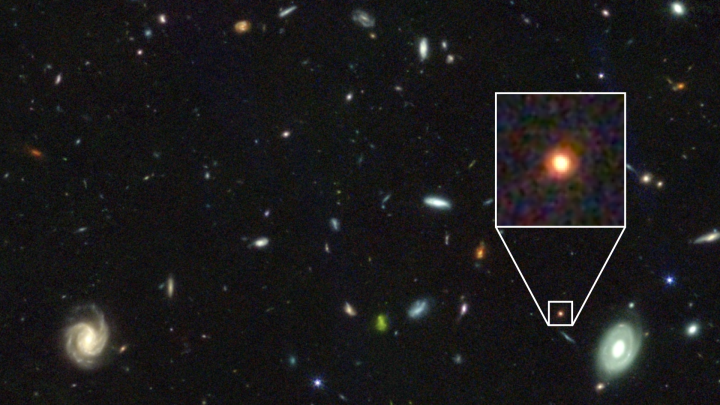2023-05-22 エディンバラ大学

GS-9209 observed by the James Webb Space Telescope next to other galaxies
◆この研究はジェームズ・ウェッブ宇宙望遠鏡によるもので、銀河の成長と初期宇宙の歴史を詳細に調査したものである。
<関連情報>
- https://www.ed.ac.uk/news/2023/ancient-galaxy-traits-revealed-space-telescope
- https://www.nature.com/articles/s41586-023-06158-6
赤方偏移4.658の巨大な静止銀河が発見される A massive quiescent galaxy at redshift 4.658
Adam C. Carnall,Ross J. McLure,James S. Dunlop,Derek J. McLeod,Vivienne Wild,Fergus Cullen,Dan Magee,Ryan Begley,Andrea Cimatti,Callum T. Donnan,Massissilia L. Hamadouche,Sophie M. Jewell & Sam Walker
Nature Published:22 May 2023
DOI:https://doi.org/10.1038/s41586-023-06158-6
Abstract
The extremely rapid assembly of the earliest galaxies during the first billion years of cosmic history is a major challenge for our understanding of galaxy formation physics (1; 2; 3; 4; 5). The advent of JWST has exacerbated this issue by confirming the existence of galaxies in significant numbers as early as the first few hundred million years (6; 7; 8). Perhaps even more surprisingly, in some galaxies, this initial highly efficient star formation rapidly shuts down, or quenches, giving rise to massive quiescent galaxies as little as 1.5 billion years after the Big Bang (9; 10), however, due to their faintness and red colour, it has proven extremely challenging to learn about these extreme quiescent galaxies, or to confirm whether any exist at earlier times. Here we report the spectroscopic confirmation of a massive quiescent galaxy, GS-9209, at redshift, z = 4.658, just 1.25 billion years after the Big Bang, using JWST NIRSpec. From these data we infer a stellar mass of M∗ = 3.8 ± 0.2 × 1010 M⊙, which formed over a ≃ 200 Myr period before this galaxy quenched its star formation activity at z=6.5+0.2−0.5, when the Universe was ≃ 800 million years old. This galaxy is both a likely descendent of the highest-redshift submillimetre galaxies and quasars, and a likely progenitor for the dense, ancient cores of the most massive local galaxies.



